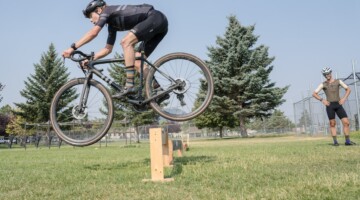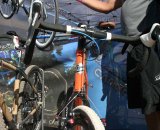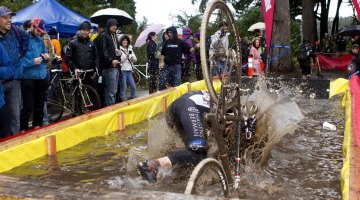by Kenton Berg
A QUIET STORM:
Amidst all the carbon bling, lightweight parts and new gadgets showing up at Interbike this year, a small company is making big impressions in the drive train market. Gates Carbon Drive Systems, an offshoot of Gates Corporation, released its first lightweight carbon belt drive system in 2008 on four bike models and quickly attracted more companies into its fold. Now, just three years later, even more bike manufacturers have jumped on board, and the number of models sporting Gates drives has grown to 43 – and that number is expected to double in 2011. The reason: well there are many, including that the system is lightweight, clean, quiet and low maintenance. [See our recent Product Spotlight on the Limited Edition Raleigh SSCXWC with Gates Carbon Belt Drive.]
THE RIDE:
Built to run only on singlespeed or internally-geared hubs – like the Rohloff or Nuvinci – the Carbon Drive System has quickly taken hold of the market in these areas and is gaining momentum. After getting the opportunity to ride and race a bike equipped with this system at the CrossVegas Wheelers and Dealers race, I can fully understand why. My six-mile ride from Interbike to the Desert Breeze soccer complex for the racing was a good way to feel out the drive train. Stopping, starting and accelerating in traffic all felt extremely smooth, and as I rode on the confidence in this drive began to grow. Let’s face it, when you jump on a bike with a completely different style of drive train you are wary. As a rider, confidence in your equipment is key, and mine built steadily as I pushed the bike more and more.
Once at the race venue I was able to really put it through its paces. I simulated a start – very smooth and no jumps or twinges of the belt. I hammered over the rough and bumpy section and the belt didn’t miss a beat.
I hit the sweeping left uphill and ground out the watts to get up the slow grass – again, not a hiccup. I hit the TRP barriers and the two sets of stairs – on and off the bike with no noise, no chain (er, belt) noise or drop. So after four warm-up laps and four laps of full-tilt racing, my impressions of this drive system are very good. Not once did I feel any slip, any tweak, or anything other than the belt delivering full power as I churned the pedals. In fact, the only “odd” thing about the carbon drive is the feel when back pedaling. This was not an issue, just something that felt different.
To further the company’s quest and show how well this application works for ’cross, Gates has assembled a five-man singlespeed cyclocross team to tear up Colorado’s ACA (American Cycling Association) circuit and other assorted races this year. The team made its first appearance at CrossVegas and quietly laid down a solid set of placings. The following weekend they amassed another set of stellar results at ACA events on both Saturday and Sunday, with the team sweeping the singlespeed category on Sunday. You can follow the efforts and exploits of the Gates team here.
PROS and CONS:
As with any bike product you may invest in, the pros and the cons must be assessed. With the Carbon Drive System here is how I see them laying out:
PROS:
- Lightweight (the front and rear sprockets plus the belt weigh a svelte 240g)
- Quiet
- Clean (the systems does not require any lubrication)
- Low maintenance
- No belt stretching (Gates field tests have shown that the belt will last twice as long as a chain)
- Sheds mud (Gates calls this the “worlds first self-cleaning drive train” as the mud ports shed dirt and grime easily)
- 20+ frame manufacturers on board and delivering Carbon Drive bikes including: Raleigh, Trek, Spot, Norco, Co-Motion and Seven. Look for many more options and models to come
CONS:
- The system can only be used on bikes that are “Gates ready” because the rear triangle needs to open up for the belt to be installed
- Increased puncture repair hassle due to belt tension needs and possible lost or stripped bolts
- Shop knowledge (although this will increase as more shops and manufacturers adapt to the system)
SUMMARY:
Gates Carbon Drive bikes have been ridden all over the world by many different types of riders, and we are now seeing how effective this type of system can be for cyclocross racing. Look for more information to come from Cyclocross Magazine as we will be doing a full review of the system once we get our test bike and put it through multiple races, training rides and an assortment of conditions. We also haven’t experimented with changing cogs for different gear ratios – a process similar to any singlespeeder’s routine. With this system, one belt drive can cover slight adjustments in gear range before a different-sized belt will be required.
I will say that the first impressions of the carbon drive system were fantastic and it looks like this technology is here to stay and progress. In fact, Gates has already announced their next generation product called CenterTrack. Carbon belts with the new CenterTrack technology have a ridge down the middle which keeps the drive better locked to the hub. That way, if the wheel placement is slightly off, the drive and hub will still interface properly. Read more about that here.
Kenton has good company in race-testing the Gates Carbon Belt Drive. According to Gavin Hayes of Spot Bikes, it’s also been race proven in 24 Hour Worlds, took a top three at the Breck Epic and faced 18 Hours of Fruita. The bike that Kenton tested was a 3.9lb OX Platinum Spot frame with a custom-drawn down tube.
Photo Gallery:
For more info: carbondrivesystems.com.
Gates Carbon Drive – CX Magazine’s first impressions
A QUIET STORM:
Amidst all the carbon bling, lightweight parts, and new gadgets showing up at Interbike this year a small company is making big impressions in the drive train market. Gates Carbon Drive Systems (www.carbondrivesystems.com), an offshoot of Gates Corporation, released their first lightweight carbon belt drive system in 2008 on four bike models and quickly attracted more companies into its fold. Now, just 3 years later, even more bike manufacturers have jumped on board and the number of models sporting Gates drives has grown to 43 and that number is expected to double in 2011. The reason…well there are many, including that the system is light weight, clean, quiet, and low maintenance.
THE RIDE:
Built to run only on single speed and internally-geared bikes, the Carbon Drive System has quickly taken hold of the market in these areas and is gaining momentum. After getting the opportunity to ride and race a bike equipped with this system at the Cross Vegas Wheelers and Dealers race I can fully understand why. My 6 mile ride from Interbike to the Desert Breeze soccer complex for the racing was a good way to feel out the drive train. Stopping, starting, and accelerating in traffic all felt extremely smooth and as I rode on the confidence in this drive began to grow. Let’s face it, when you jump on a bike with a completely different style of drive train you are wary…as a rider, confidence in your equipment is key, and mine built steadily as I pushed the bike more and more. Once at the race venue I was able to really put it through its paces. I simulated a start – very smooth and no jumps or twinges of the belt. I hammered over the rough and bumpy section – the belt didn’t miss a beat.
I hit the sweeping left uphill and ground out the watts to get up the slow grass – again, not a hiccup. I hit the TRP barriers and the 2 sets of stairs – on and off the bike with no noise, no chain (er, belt) noise or drop. So after 4 warm up laps and 4 laps of full-tilt racing my impressions of this drive system are very good. Not once did I feel any slip, any tweak, or anything other than the belt delivering full power as I churned the pedals. In fact, the only “odd” thing about the carbon drive is the feel when back pedaling. This was not an issue, just something that felt different.
To further their quest and show how well this application works for Cross, Gates has assembled a five man single speed cross team to tear up the ACA circuit and other assorted races this year. The team made its first appearance at CrossVegas and quietly laid down a solid set of placings (http://www.crossvegas.com/site/index.php). The following weekend the amassed another set of stellar results on both Saturday and Sunday with the team sweeping the single speed category on Sunday. You can follow the efforts and exploits of the Gates team here (http://blog.carbondrivesystems.com/).
PROS and CONS:
As with any bike product you may invest in the pros and the cons must be assessed. With the Carbon Drive System here is how I see them laying out:
PROS:
– Lightweight (the front and rear sprockets plus the belt weigh a svelte 240g)
– Quiet
– Clean (the systems does not require any lubrication)
– Low maintenance
– No belt stretching (Gates field tests have shown that the belt will last 2 times longer than a chain)
– Sheds mud (Gates calls this the “worlds first self-cleaning drive train” as the mud ports shed dirt and grime easily)
– 20+ manufacturers on-board and delivering Carbon Drive bikes including: Raleigh, Trek, Spot, Norco, Co-Motion, and Seven. Look for many more options and models to come
CONS:
– The system can only be used on bikes that are “Gates ready” whereby the rear triangle needs to open up for the belt to be installed
– Increased puncture repair hassle due to belt tension needs and possible lost or stripped bolts
– Shop knowledge (although this will increase as more shops and manufacturers adapt to the system)
SUMMARY:
Gates Carbon Drive bikes have been ridden all over the world by many different types of riders and we are now seeing how effective this type of system can be for Cross racing. Look for more information to come from CX Magazine as we will be doing a full review of the system once we get our test bike and put it through multiple races, training rides, and an assortment of conditions. I will say that the first impressions of the carbon drive system were fantastic and it looks like this technology is here to stay and progress. In fact, Gates has already announced their next generation product called CenterTrack. Read more at http://blog.carbondrivesystems.com/?p=740
Thanks again to the Gates crew who made my ride at Cross Vegas possible! Visit www.carbondrivesystems.com for full information on the system, partners, and where to buy.



































